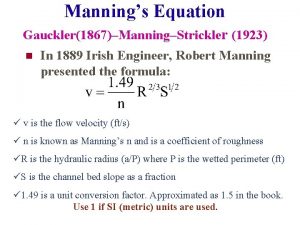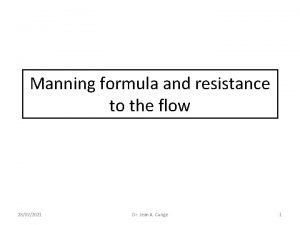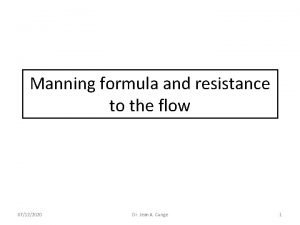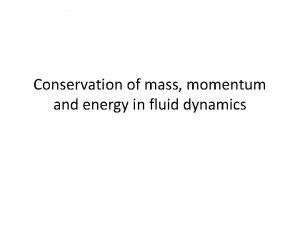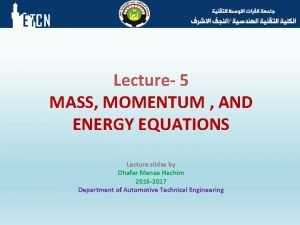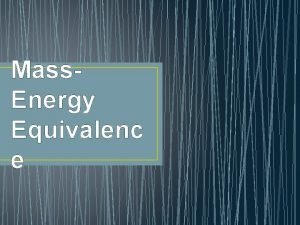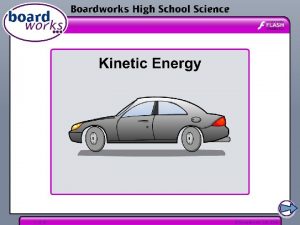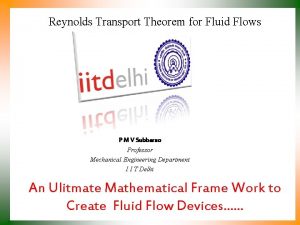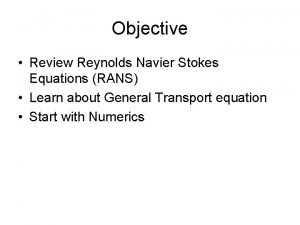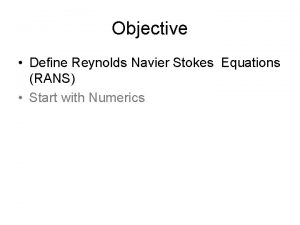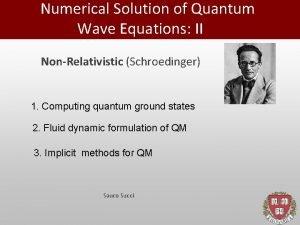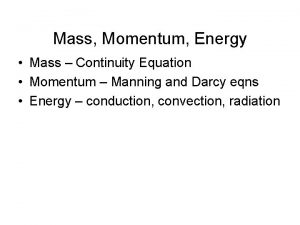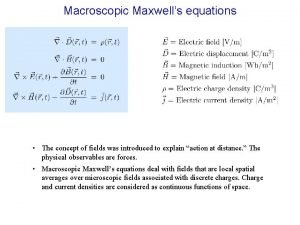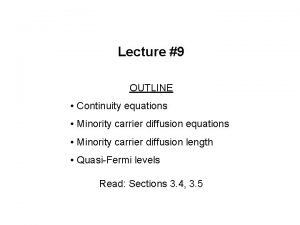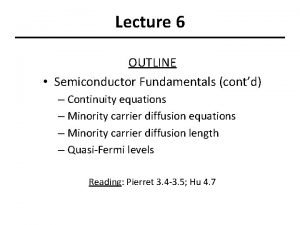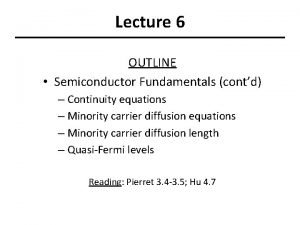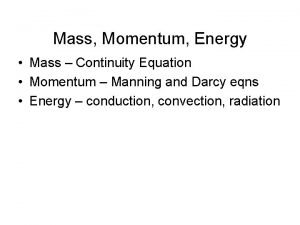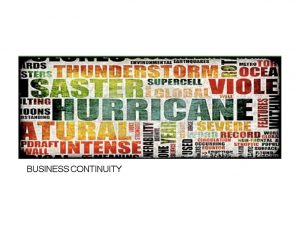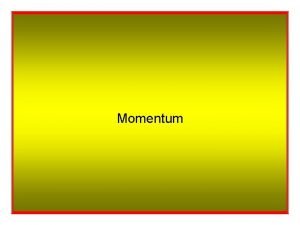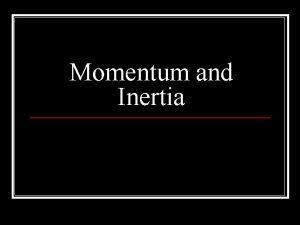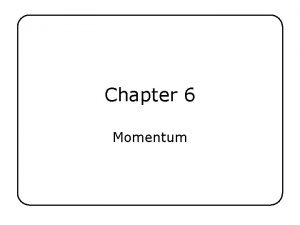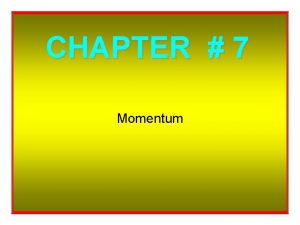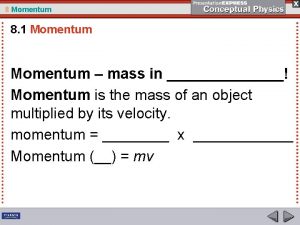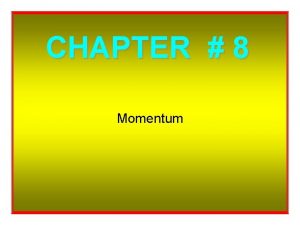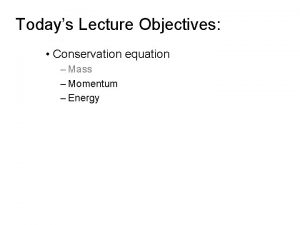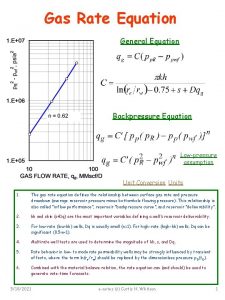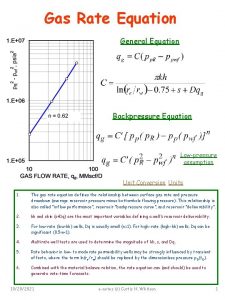Mass Momentum Energy Mass Continuity Equation Momentum Manning












![Energy fluxes and flows • Water Volume [L 3] (acre-ft, m 3) • Water Energy fluxes and flows • Water Volume [L 3] (acre-ft, m 3) • Water](https://slidetodoc.com/presentation_image/00af320ccc5c154dc09454332197726e/image-13.jpg)

![Water Mass Fluxes and Flows • Water Volume, V [L 3] (acre-ft, m 3) Water Mass Fluxes and Flows • Water Volume, V [L 3] (acre-ft, m 3)](https://slidetodoc.com/presentation_image/00af320ccc5c154dc09454332197726e/image-15.jpg)




- Slides: 19

Mass, Momentum, Energy • Mass – Continuity Equation • Momentum – Manning and Darcy eqns • Energy – conduction, convection, radiation

Reynolds Transport Theorem Total rate of change of B in the fluid system Rate of change of B stored in the control volume Net outflow of B across the control surface

Continuity Equation B = m; b = d. B/dm = dm/dm = 1; d. B/dt = 0 (conservation of mass) r = constant for water hence or

Ij Qj Continuity Equation, d. S/dt = I – Q applied in a discrete time interval [(j 1)Dt, j. Dt] DSj = Ij - Qj Dt j-1 Sj = Sj-1 + DSj j

Momentum B = mv; b = d. B/dm = dmv/dm = v; d. B/dt = d(mv)/dt = SF (Newtons 2 nd Law) For steady flow For uniform flow so In a steady, uniform flow

Energy equation of fluid mechanics hf energy grade line y 1 water surface y 2 bed z 1 L Datum How do we relate friction slope, z 2 Geoid to the velocity of flow?

Open channel flow Manning’s equation Channel Roughness Channel Geometry Hydrologic Processes (Open channel flow) Hydrologic conditions (V, Sf) Physical environment (Channel n, R)

Subsurface flow Darcy’s equation Hydraulic conductivity Hydrologic Processes (Porous medium flow) Hydrologic conditions (q, Sf) Physical environment (Medium K) q A q

Comparison of flow equations Open Channel Flow Porous medium flow Why is there a different power of Sf?

Energy B = E = mv 2/2 + mgz + Eu; b = d. B/dm = v 2/2 + gz + eu; d. E/dt = d. H/dt – d. W/dt (heat input – work output) First Law of Thermodynamics Generally in hydrology, the heat or internal energy component (Eu, dominates the mechanical energy components (mv 2/2 + mgz)

Heat energy • Energy – Potential, Kinetic, Internal (Eu) • Internal energy – Sensible heat – heat content that can be measured and is proportional to temperature – Latent heat – “hidden” heat content that is related to phase changes

Energy Units • In SI units, the basic unit of energy is Joule (J), where 1 J = 1 kg x 1 m/s 2 • Energy can also be measured in calories where 1 calorie = heat required to raise 1 gm of water by 1°C and 1 kilocalorie (C) = 1000 calories (1 calorie = 4. 19 Joules) • We will use the SI system of units
![Energy fluxes and flows Water Volume L 3 acreft m 3 Water Energy fluxes and flows • Water Volume [L 3] (acre-ft, m 3) • Water](https://slidetodoc.com/presentation_image/00af320ccc5c154dc09454332197726e/image-13.jpg)
Energy fluxes and flows • Water Volume [L 3] (acre-ft, m 3) • Water flow [L 3/T] (cfs or m 3/s) • Water flux [L/T] (in/day, mm/day) • Energy amount [E] (Joules) • Energy “flow” in Watts [E/T] (1 W = 1 J/s) • Energy flux [E/L 2 T] in Watts/m 2 Energy flow of 1 Joule/sec Area = 1 m 2

Internal Energy of Water vapor Water Ice Water Heat Capacity (J/kg-K) 2220 4190 Latent Heat (MJ/kg) 0. 33 2. 5/0. 33 = 7. 6 2. 5 Water may evaporate at any temperature in range 0 – 100°C Latent heat of vaporization consumes 7. 6 times the latent heat of fusion (melting)
![Water Mass Fluxes and Flows Water Volume V L 3 acreft m 3 Water Mass Fluxes and Flows • Water Volume, V [L 3] (acre-ft, m 3)](https://slidetodoc.com/presentation_image/00af320ccc5c154dc09454332197726e/image-15.jpg)
Water Mass Fluxes and Flows • Water Volume, V [L 3] (acre-ft, m 3) • Water flow, Q [L 3/T] (cfs or m 3/s) • Water flux, q [L/T] (in/day, mm/day) Water flux • Water mass [m = r. V] (Kg) • Water mass flow rate [m/T = r. Q] (kg/s or kg/day) • Water mass flux [M/L 2 T = rq] in kg/m 2 day Area = 1 m 2

Latent heat flux • Water flux – Evaporation rate, E (mm/day) • Energy flux – Latent heat flux (W/m 2), Hl r = 1000 kg/m 3 lv = 2. 5 MJ/kg 28. 94 W/m 2 = 1 mm/day Temp 0 10 20 30 40 Lv Density Conversion 2501000 999. 9 28. 94 2477300 999. 7 28. 66 2453600 998. 2 28. 35 2429900 995. 7 28. 00 2406200 992. 2 27. 63 Area = 1 m 2

Radiation • Two basic laws – Stefan-Boltzman Law • R = emitted radiation (W/m 2) • e = emissivity (0 -1) • s = 5. 67 x 10 -8 W/m 2 -K 4 • T = absolute temperature (K) All bodies emit radiation – Wiens Law • l = wavelength of emitted radiation (m) Hot bodies (sun) emit short wave radiation Cool bodies (earth) emit long wave radiation

Net Radiation, Rn Ri Incoming Radiation Re Ro =a. Ri Reflected radiation a= albedo (0 – 1) Rn Net Radiation Average value of Rn over the earth and over the year is 105 W/m 2

Net Radiation, Rn H – Sensible Heat LE – Evaporation G – Ground Heat Flux Rn Net Radiation Average value of Rn over the earth and over the year is 105 W/m 2
 Absolute continuity implies uniform continuity
Absolute continuity implies uniform continuity Chezy constant formula
Chezy constant formula Mannings formula
Mannings formula Manning equation
Manning equation Resistance formula physics
Resistance formula physics Manning's formula
Manning's formula Mass momentum and energy conservation
Mass momentum and energy conservation Conservation of mass momentum and energy equations
Conservation of mass momentum and energy equations Stoichiometry ratio
Stoichiometry ratio How does the mass-energy equation e= mc 2relate to fission?
How does the mass-energy equation e= mc 2relate to fission? Kinetic energy formula
Kinetic energy formula Reynolds transport equation
Reynolds transport equation Equazioni di navier stokes
Equazioni di navier stokes Navier stokes equation momentum
Navier stokes equation momentum Schröndiger
Schröndiger Equation of continuity
Equation of continuity Maxwell's equations
Maxwell's equations Minority carrier diffusion equation
Minority carrier diffusion equation Continuity equation of semiconductor
Continuity equation of semiconductor Derive equation of continuity
Derive equation of continuity


